We talk so much about EV range, performance specs, and software updates, but how often do we think about the actual air we’re breathing inside these machines? Turns out, one Rivian R1T owner did, and what he found might point to a gap in how automakers like Rivian approach cabin air quality. So I was scrolling through the “RIVIAN Electric Vehicles Discussion” group on Facebook this morning and came across a post by Benjamin Ponds. Benjamin had been monitoring the CO₂ levels inside his Rivian R1T using two calibrated meters. He discovered that, during typical driving conditions with the HVAC system set to auto mode, CO₂ concentrations inside the cabin would rise. It would often exceed 2,000 ppm within 30 minutes of driving, and when idling in traffic, levels climbed as high as 3,000 ppm. This raised a serious question in his mind: are Rivian’s HVAC engineers truly prioritizing the air we breathe inside these otherwise forward-thinking electric trucks?
Here’s Benjamin’s full post that brought the issue into focus:
“I have been monitoring CO₂ levels inside my R1T while driving and working this past week. I'm using two different meters simultaneously to verify I'm getting fairly accurate readings, and both have recently been recalibrated to ambient air which is typically around 400 ppm. My typical day can include a 45min–2hr trip, then easily 5–8 stops during the day, and then I ride home. I'm testing with the climate on auto mode. In the mornings, the cabin is usually in the 600 ppm range. Driving solo, the meter with the fastest sensor beeps first warning of 1,500 ppm within 25 minutes of driving. With the family, it happens in 15 minutes. At the 30-minute mark, it alerts at the next warning level, with one exception over the last week, of crossing 2,000 ppm even when solo driving.
When sitting in the truck in traffic, making calls, etc. for 20 minutes, it reaches 2,700–2,900 ppm. I've noticed that on auto mode, the truck will occasionally switch to fresh air and the level drops to the 1,300–1,500 ppm range for a few minutes, then climbs back to the low 2,000s. As I sit here now in the truck for 25 minutes, the faster response sensor just alerted 3,000 ppm. Climate is on auto and hasn't been touched other than temperature all day.
These results do not prove but definitely support my hypothesis that Rivian engineers have not taken CO₂ level control seriously, and they need to revamp the HVAC controls to support a human-friendly cabin environment. All medical documentation I've found, common respiratory recommendations, etc. have drowsiness beginning at 1,000 ppm CO₂ for many people, and that's the recommended level to stay under for prolonged periods. Over 2,000 ppm is sometimes associated with dizziness, brain fog, etc. It gets more drastic as the ppm count rises and exposure time rises, obviously. Manually switching climate to fresh air intake makes the CO₂ ppm count drop from 3,000 ppm to under 600 ppm within 5 minutes. So my original observation and frustration post about the climate constantly 'choosing' recirculate being a potential hazard seems to be grounded in logic, truth, backed by real data, and a concern of habitable environments for modern medicine as well.” He even provided a link to support his research of the potential health trade offs.
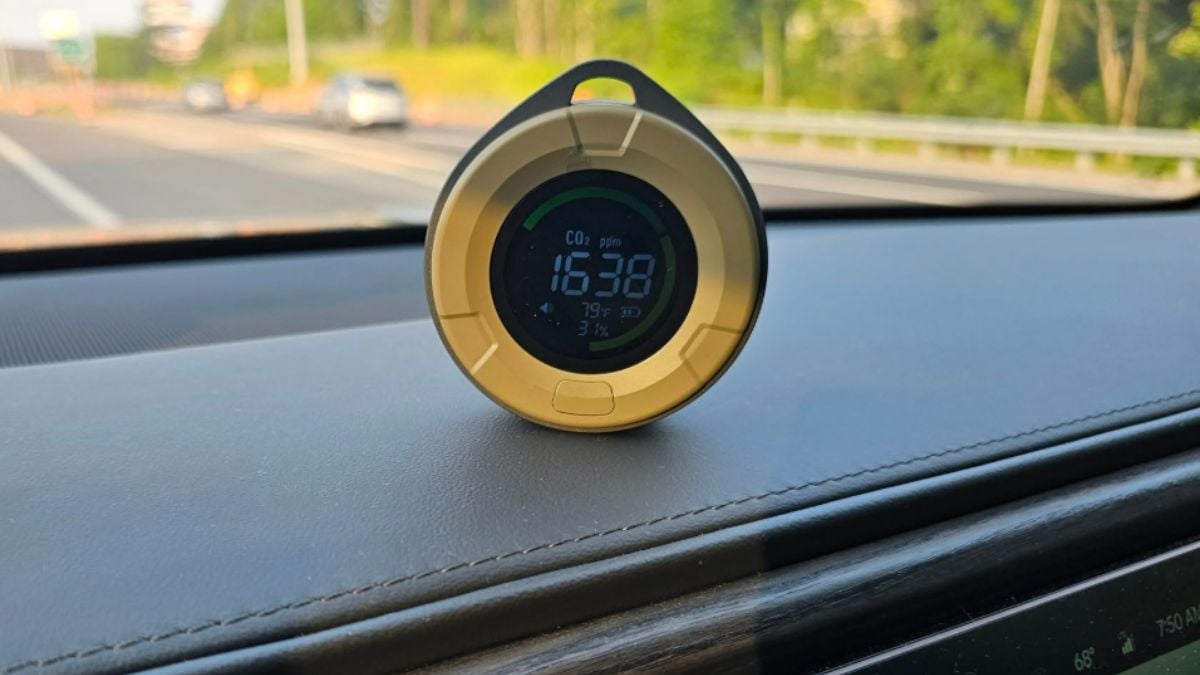
What Others Are Saying
Benjamin’s post quickly caught attention. I mean after all, it was detailed, well-researched, and backed by real-world testing. One commenter, Mike Shelton, asked an important question: “Have you performed this testing in any other vehicles for comparison?” Benjamin replied with insight:
“My primary point is in both my other vehicles, they will never switch themselves to recirculate on their own like Rivian does. Rivian seems to be highly preferring recirculation over fresh air, possibly to boost A/C performance. I'm not sure why exactly. Every car made will have excess CO₂ levels inside when left on recirculation. I've tested my gasoline cars and you also get the benefit of increasing your CO levels. Also, if you have any kind of exhaust header leak like our Odyssey.”
That comment alone started a discussion around how different automakers approach climate logic and the trade-offs they make between energy efficiency and interior air quality. Another user, Shelton Don Caramelo Stevens, added:
“This is why I love Facebook groups and other forum platforms. I probably never would have even thought about this, but I learned something interesting and useful today. Thank you, seriously.”
Me too Shelton. His point is powerful after all, as online forums like these are exposing aspects of ownership that simply don’t show up on spec sheets or press releases. Real-world use brings out real-world flaws, with some potential safety concerns.
Martin Bogomolni provided some medical context, noting: “The National Collaborating Centre for Environmental Health (NCCEH) considers 7,000 ppm to be the lowest level at which a health effect has been observed in humans, and that was after several weeks of continuous exposure. That's not to say that a level of 2,000 to 3,000 ppm can’t be improved, but at the same time, those are subclinical levels of exposure for most of the population.”
It’s a fair point, and one that offers some balance. But as Benjamin pointed out, the thresholds for symptoms like brain fog and drowsiness can be lower. Plus, the danger isn’t about acute toxicity here, but about decreased alertness and comfort while driving. That’s a big deal in a truck that’s made for road trips and long daily hauls.
Garrett Buckland had a different interpretation: “This sounds like an excellent feature of the Rivian. Having true recirculation without leaks is a sign of proper functioning HVAC that’s set to Recirculate. If you want outside air, open the window or push the button on the screen. Great validation of the air-tightness of the vehicle and build quality of the HVAC.”
But is this a feature, or a flaw? Many Rivian owners likely assume that Auto mode is actively managing air quality, not just temperature. And in other EVs, like Teslas or certain luxury hybrids, the vehicle intelligently toggles between fresh and recirculated air to maintain both comfort and safety.
The Broader Rivian Experience
So while prioritizing range and cabin consistency makes sense, automakers may need to strike a better balance when it comes to recirculation strategies and overall air quality. But that’s not to say Rivian isn’t winning people over, as one R1T driver even shared their unexpected transformation from EV skeptic to loyalist after giving the truck a chance.
Separately, concerns about quality and service delays have surfaced among owners. One Rivian R1T owner revealed how a service appointment dragged on much longer than expected, leading to frustration and a deeper reflection on the brand’s early production hurdles.
A more technical failure involved a Rivian R1S that experienced extensive interior flooding due to a misrouted HVAC drain line, a defect that rendered the vehicle undriveable just weeks after delivery. The story brought to light how even advanced vehicles can fall victim to basic engineering oversights.
And finally, some Rivian customers have faced other kinds of challenges too. An owner was denied the Colorado EV tax credit despite their vehicle meeting the published weight criteria, as another example. This sparked questions about how incentives are applied in practice and whether EV buyers are being left behind by the system.
As for me though, taking account all these different ownership experiences, I think this whole situation shows how the smallest overlooked system can have an impact. You can have all the range, power, and tech in the world, but if your climate control quietly builds up air that makes you tired and less alert behind the wheel, that could prove to be an issue. It's true for any car maker, but especially true in a vehicle that’s marketed for adventure, road trips, and long hauls.
Key Takeaways:
- Benjamin’s data-backed post suggests that Rivian’s Auto climate control setting may not manage CO₂ levels adequately during normal driving.
- Elevated CO₂ levels can impair cognitive function, cause drowsiness, and go unnoticed until symptoms arise.
- While some argue the levels found are still “safe,” many sources often set much lower thresholds for optimal performance.
- Other Rivian owners have reported quality concerns, reinforcing that reliability and detail-oriented design remain a work in progress. Even with some loaner vehicles having failed while in service.
What Do You Think?
Have you ever experienced fatigue or fogginess during a long drive in your car and didn’t know why?
And do you think cabin air quality is something automakers should take more seriously in the Auto climate setting in the future?
I'd love to hear your take in the comments section below.
Aram Krajekian is a young automotive journalist bringing a fresh perspective to his coverage of the evolving automotive landscape. Follow Aram on X and LinkedIn for daily news coverage about cars.
Image Sources: The “RIVIAN Electric Vehicles Discussion” public Facebook group.


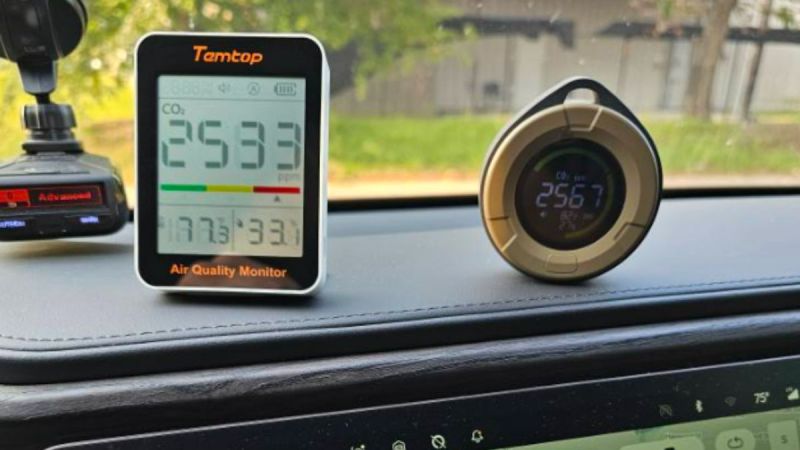




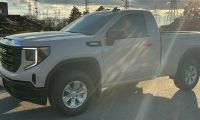
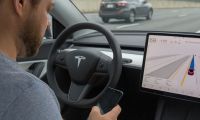

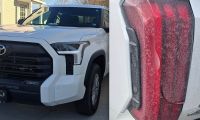
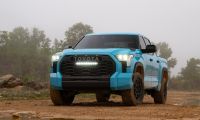
Comments
Where is CO2 being made in…
Permalink
Where is CO2 being made in an electric vehicle?
Gee I don't know maybe the…
Permalink
In reply to Where is CO2 being made in… by Pdeclerck (not verified)
Gee I don't know maybe the humans occupying the electric vehicle?
He found 2000ppm of CO2. If…
Permalink
He found 2000ppm of CO2. If I was a journalist I might find out what the experts state are safe levels. So, after some very intensive and time consuming research (Consisting of asking Google "What are safe levels of CO2?") - We find that OSHA has determined that you can safely be exposed to 5,000 ppm for 8 hours. Then, being the thorough journalist, i might ask the Rivian owner why he is worried when the max level he found was less than 1/2 the level considered safe by science. But that's just me....
I totally get you Bubba. But…
Permalink
In reply to He found 2000ppm of CO2. If… by Bubba (not verified)
I totally get you Bubba.
But according to research conducted by the NIH and the source I listed in the article, effects of CO2 causing drowsiness and heart rate can start around consistent exposure of 2-3k ppm.
Most other manufacturers…
Permalink
Most other manufacturers design recirculation with 5% to 30% fresh air mix to prevent this type of problem. I keep this in mind when carrying extra occupants, and will manually turn recirculation off in our Buick if it's more than just my wife and I. In our Chrysler, the amount of fresh air mixed with recirculation is adjustable on the dash, and I've just gained a new appreciation for that feature.
The levels are time weighted…
Permalink
The levels are time weighted for 8hrs. The article states 1000 to 3000 levels. Averages to 2000. You also need to not open the door for 8hrs. Accumulated exposure is key. There is no issue with these levels. Levels of 5000 at 8hrs continues are siginificant. 40,000 level you should leave immediately.
He's breathing. Great…
Permalink
He's breathing. Great analysis. If the CO2 levels drop to half of what they are now, plant life will begin to die. What follows will be total annihilation. BTW, the earth, Mother planet, synthysizes the elements which continuously produce hydrocarbons. They never were "fossil fuel".
The car wanting to switch to…
Permalink
The car wanting to switch to recirc mode is to preserve the life of the HEPA cabin filter. When the same air keeps passing the filter there is less "stuff" to collect. On the other hand a constant flow of outside air will drastically reduce the effective life of the cabin purification filter.
How much did Tesla pay for…
Permalink
How much did Tesla pay for this thinly-veiled hatchet job?
I have a solution. Decorate…
Permalink
I have a solution. Decorate inside your Rivian with a few small potted plants, some ivy or ferns.
Good one. Submariner…
Permalink
In reply to I have a solution. Decorate… by Mean While (not verified)
Good one. Submariner weighing in. Instead of a CO2 scrubber (circulating monoethanolamine) imagine plants on the dashboard sucking it up? Germany's Sono Motors Scion EV (with Finland assembly) with thin film solar panels (330 modules 7.5 m /81 ft 1.2 KW for a Max 34 km/21 MI a day range added - expecting six average miles per day each year) had reindeer Moss they termed 'BreSono' placed within the center console dashboard - able to filter 20% of air particulate through enzymatic reaction, a sort of sponge property both controlling humidity as a 'buffer' comfortably adding or reducing humidity in a novel biologically balanced arrangement.
This forward looking group provided CAD data of all spare parts (reSono) that you could 3D print or have CNC milled replacement parts - with how to videos and a catalog of instructions on the site - this makes car repair accessible to anyone with a local makerspace
The intended to also offer electric power from the car, and ride share the car (goSono) through the phone app
-and intended 100% Renewable Power to put the cars together in the factory, but by February 2023, had insufficient funding to continue development.
-Norway has made a national priority, utilizing the sovereign wealth fund to subsidize EV adoption, but this was between Germany planners and Finland producers. If only the people with the money connected with the people with the ideas, the world would be better with these innovations.
**Look at China: LG Chem was initially making cell phone and laptop batteries and now they have boosted full on into cars ... Meanwhile the French Renault Zoe is the best selling plug-in electric car in Europe with over 284,000 units registered, followed by the Renault 'Kangoo ZE' van with 22 KW charging, 45 KWh battery for 160 - 180 mi of range including regenerative braking
*with over 60,000 sold in Europe since 2010. 65% of their vehicles are electric with a plan to produce up to 90% Electric for more than a million vehicles by 2030 (within 4.5 years) - sporting a e-power train mega factory in Normandy with a gigafactory in progress, partnering with STmicroelectronics, Whylot, LG chem, AESC, and Verkor
The most popular German electric car is Volkswagen ID.3 sold 57,000 units in 2020 alone. Italy has around that many in the country due to high cost of electricity, but ride sharing is required to be electric since 2024.
There are 2 million owners of electric cars in the United States, with one in four cars sold worldwide Electric, according to the International Energy Agency and EVS are expected to be 40% of global car sales by 2030.
This is an incredibly…
Permalink
In reply to Good one. Submariner… by Phil (not verified)
This is an incredibly thoughtful and informative comment Phil.
The example of Sono Motors is a perfect reminder of how creativity, sustainability, and accessibility can go hand-in-hand. Thanks for sharing your thoughts.
After polyurethane foam off…
Permalink
After polyurethane foam off gassing and micro plastic shedding, CO2 is the least of your worries.
You know he's lying right…
Permalink
You know he's lying right off the bat purely from the numbers he chose. "Oh man I've been driving in 3k ppm for as long as I've had the Rivian, and I'm perfectly fine everytime, even though I'm claiming I will be blacked out at 3k ppm."
In occupational medicine,…
Permalink
In occupational medicine, and Industrial hygiene, CO2 levels are measured as a marker of ventilation. Outside here is usually for 100 to 500 parts per million, and depending on the area there could be more. Levels above 1000 parts per million are a marker for poor enough ventilation other substances in the air could accumulate enough to cause symptoms.
Yeah, but when you have…
Permalink
Yeah, but when you have fresh air option on, you're smelling the nasty exhaust from other cars and diesel trucks. What's worse? Carbon dioxide or other nasty car exhaust??????? I prefer carbon dioxide.
Just get a Tesla
Permalink
Just get a Tesla
Where's the actual…
Permalink
Where's the actual experiment?
This is dumb. I've worked with enviro controllers for years and had to design hydroponic spaces(not for the cannabis industry) those cheap meters suck, you can breathe in their general direction and send the CO2 levels sky high. We turned it into a game once on a job site I worked. Might want to look up the US naval study on CO2 in enclosed spaces. What you're saying really doesn't track and sounds like a forced bias. I can probably achieve the same results in a 2012 Subaru Impreza, or get those levels even higher in my 82 F150. Not to mention if you add one more person to the vehicle. Hell if this was really a severe issue everyone who carpools during the summer would be dead. Or worse the winter. So dumb article.
Some people have too much…
Permalink
Some people have too much wasted time In their lives. There are better things to worry about, POTOS, as one example. I guess small thinking 🤔 😕 people need something to worry about
Humans release 40,000ppm in…
Permalink
Humans release 40,000ppm in co2 in every breath so why would 3000ppm in small area be anyway harmful?
Pagination